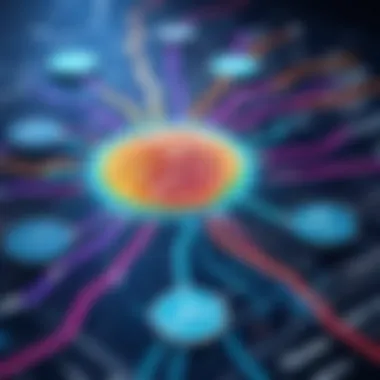Mastering Memory Techniques for Enhanced Learning Retention


Intro
Memory techniques are more than mere tools; they are essential pathways to unlocking potential within the human mind. The ability to retain, recall, and utilize information plays a pivotal role, particularly in fast-paced environments influenced largely by advancing technology. Focusing on diverse cognitive styles, this article explores various memory enhancement strategies. Each offers fascinating insights into how memory works and how one can systematically improve retention.
This exploration extends beyond simple memorization techniques to a deeper understanding of cognitive processes informing these strategies. Consequently, readers armed with the right techniques stand to significantly enhance their learning efficiency. While the landscape of memory improvement fluctuates, well-founded strategies remain a constant force on which individuals can rely.
The overarching goal is to arm readers with practical applications of memory techniques geared toward everyday situations.
Technology Insights
The rapid evolution of technology impacts nearly every aspect of our daily lives, including how we learn and remember. Here, we will explore how technology integrates with memory techniques.
Latest Tech Trends
Technological advancements influence methods of learning and memory in numerous ways. Already, numerous tools harness Artificial Intelligence, machine learning, and augmented reality. Applications designed to train and enhance memory utilizing fun and interactive design instruct individuals how to retain information better. Consider applications that gamify memory training, such as Lumosity or Elevate. They not just motivate users but also create powerful experiences that cement learned content.
Innovation in Tech
Aside from apps meant solely for memory enhancement, innovations embrace wearable tech that successfully tracks cognitive function. An example is Muse, a headband device that monitors brain activity, helping individuals understand their focus and relaxation states. While exploring one's mentorship potential, it can ultimately refine memory effectiveness. In the near future, we foresee further integration of memory-focused exercises through integration with VR technology which adds to the spatial memory enrichment experience, carving beneficial trajectories for personalized learning.
Product Reviews
- Anki: This flashcard software employs spaced repetition algorithms, enhancing long-term spurts of data recall. Studies reveal increased retention rates, making it invaluable for students.
- MemoryPalace: This application aids users in creating virtual subconsciously mapped memories. It is based on techniques widely recognized by past scholars, simplifying associations and recall in daily situations.
- Mammoth Memory: The platform offers resources and techniques on effective memory creation processes via a straightforward instructional format. Users see practical gains within days—just click through, watch with a critical eye, own methods that lead to enhanced retention.
Understanding Memory
Understanding the intricacies of memory is pivotal for mastering techniques that enhance learning and retention. Memory isn't just a passive storage system; it is a dynamic process crucial for daily decision-making and information assimilation. By grasping how memory operates, individuals can opt for methods that efficiently suit their learning affinities. This insight is particularly relevant in an age marked by rapid information transfer.
The Psychological Foundation of Memory
Memory's psychological foundation involves complex cognitive processes that shape how we encode, store, and retrieve information. These processes rely on external stimuli and internal associations. Theories of memory often categorize it into different models. One prominent model is the Multi-store model, which divides memory into sensory memory, short-term memory, and long-term memory. Understanding these components can lead to better cognitive strategies for retention.
Important Concepts:
- Encoding: The way information is perceived and processed.
- Storage: How information is maintained over time.
- Retrieval: The ability to access memories when needed.
A well-grounded awareness of these psychological elements can significantly improve one's ability to employ memory enhancement techniques effectively.
Types of Memory: Short-term vs Long-term
Short-term and long-term memory serve distinctive functions in our overall capacity to learn. Short-term memory, often a temporary holding area for information, usually lasts seconds to minutes without rehearsal. It holds about seven items plus or minus two. Conversely, long-term memory is essentially limitless and can endure for years or even a lifetime.
In practical terms:
- Short-term Memory (working memory): Used for immediate tasks, like solving a math problem pieces of information.
- Long-term Memory: Crucial for holding expansive knowledge, experiences, and skills acquired over time.
Understanding these types enables individuals to harness techniques that target either short-term retention strategies or projects designed to solidify information within the long-term memory store.
The Role of Attention in Memory Formation
Attention is critical for memory formation as it determines what information is prioritized for encoding into memory. When attention is scattered, data may pass through sensory memory without getting filed appropriately. Concentrated focus fosters robust memory traces, improving recall abilities.
Considerations Regarding Attention:


- Distraction diminishes encoding effectiveness.
- Engaged attention embodies effective listening, wherein individuals grasp contextual details facilitating memory recall.
- Active involvement, such as rephrasing and elaborating on information, greatly enhances retention.
In summary, enhancing attention is key to constructing a lasting memory. Techniques designed to improve focus can complement memory methods, resulting in more efficient learning experiences.
The Science Behind Memory Techniques
The field of memory techniques is grounded in scientific research, making it essential to understand the underlying principles that inform these techniques. Scientific studies illuminate how our brains store and retrieve information, offering tangible methods for improving memory retention. Understanding these complexities is vital for effective implementation in personal and professional settings.
Exploring the science strengthens our grasp of more effective learning strategies. Armed with this knowledge, one can consciously employ memory-enhancing methods that cater to individual cognitive processes.
Cognitive Load Theory
Cognitive Load Theory suggests that the human brain has a limited capacity for processing information at any given time. It posits that when the information load exceeds that capacity, performance declines, and thus, learning suffers. This principle underlines the importance of structuring information in a way that makes it more manageable for learners.
When considering memory techniques, applying Cognitive Load Theory is advantageous in these ways:
- Information Segmentation: Techniques like chunking allow breaking down complex information into smaller, digestible units. Moving from large blocks of information to more manageable segments enhances retention.
- Active Learning: Engaging learners actively in the learning process helps facilitate understanding and integration of information. Incorporating interactive memory techniques can alleviate cognitive overload.
- Prior Knowledge: Leveraging existing knowledge provides context for new concepts, fostering better comprehension and integration. This adjustment minimizes the cognitive load by aligning new information with understood frameworks.
By prioritizing cognitive load management, students and professionals alike can improve their overall capacity for memory retention.
Neuroscience of Memory Retention
Neuroscience examines how our brain processes and retains memories. At its core, memory retention involve multiple brain structures, notably the hippocampus and prefrontal cortex. Research also reveals distinct phases of memory encoding, consolidation, and retrieval.
Several aspects are crucial when considering the neuroscience of memory:
- Synaptic Plasticity: Understanding how synapses, the connections between neurons, strengthen through repeated activation provides insight into how consistent practice forms lasting memories. Techniques such as spaced repetition take advantage of this principle by reinforcing pathways over timed intervals, enhancing long-term retention.
- Memory Consolidation: Memories transition from short-term to long-term storage primarily during sleep. This emphasizes the necessity of adequate sleep for effective memory retention. Implementing healthy sleep hygiene must accompany learning efforts to maximize outcomes.
- Neurotransmitters: Chemicals like dopamine play a pivotal role in memory formation and retrieval. One practical example is utilizing rewards for completing learning tasks. This aligns with enhancing dopamine flow, positively affecting retention and motivation.
The intersection of neuroscience and learning reinforces various techniques, enabling a more strategic approach to mastering memory.
Effective memory techniques, underpinned by cognitive and scientific principles, manifest advantageous results, leading to developed retention skills.
Techniques for Improving Memory
Improving memory is crucial for individuals who seek efficiency in learning and enhance retention of information. These techniques serve as cognitive frameworks to minimize mental fatigue and optimize intake and recall of knowledge. By mastering memory techniques, individuals increase their cognitive capabilities, enabling better performance in academic, professional, and creative pursuits. Additionally, a structured approach to memory improvement communicates a mindset oriented toward growth.
Mnemonics: A Practical Overview
Mnemonics are classic tools for enhancing memory by creating associations with information. They take diverse forms, such as acronyms and visual imagery. An essential aspect of mnemonics is simplicity; they rely on making information more memorable through structure or vivid imagery.
Here are a few examples of how they work:
- Acronyms: Like using NASA to remember *National Aeronautics and Space Administration. *
- Rhyme or Alliteration: For instance, using rhyme to remember lists (e.g., “Thirty days hath September”).
- Phrase Structures: Creating memorable phrases, such as “My Very Educated Mother Just Served Us Noodles” for the planets in order.
Using mnemonics spurs creativity and stimulates cognitive flexibility, addressing both the sensory and linguistic facets of memory.
The Method of Loci
The Method of Loci is a powerful mnemonic device that connects familiar spatial memory with information to be retained. This technique involves visualizing a well-known physical location and mentally placing pieces of information along a defined path within that context.
- Start by selecting a familiar place, perhaps your home or favorite walk.
- Identify distinct locations along that path, like rooms or landmarks.
- Associate the items to remember with these locations.
This method relies on the brain’s natural ability to remember spatial layouts. When retrieving information, visualizing and mentally walking through the locations helps trigger memories embedded in those spots.
Chunking: Breaking Information into Manageable Units


Chunking is an effective technique that simplifies complex information into digestible bites, making it easier to remember. The brain processes information better in small groups. When presented with a long string of numbers or terms, breaking it down into meaningful chunks enhances retention.
For example, the phone number 1234567890 can be chunked into 123-456-7890. Other practical applications include:
- Dividing a long list into categories or themes.
- Learning a new language by grouping words with similar meanings.
- Memorizing a long text in paragraphs.
This technique equips learners to manage cognitive load better, enhancing the overall efficacy of memory encoding.
Spaced Repetition: Timing and Spacing in Learning
Spaced repetition is a technique that supports long-term retention through distributed practice. This approach space out review sessions over increasing intervals, leveraging the forgetting curve to improve memory retention.
The primary elements include:
- Immediate Review: Reviewing material soon after learning it.
- Subsequent Intervals: Gradually increasing the intervals between review sessions (1 day, 3 days, 1 week, etc.).
Utilizing spaced repetition strengthens neural pathways and counters the effects of forgetting. An apt execution of this technique leads to deeper knowledge consolidation.
Visualization Techniques for Enhanced Memory
Visualization is about creating mental images to represent information, allowing for a tactile learning experience. This technique leverages the human brain’s outstanding capacity for visual processing.
Key points in using visualization effectively are:
- Transform abstract ideas into concrete images.
- Craft dynamic stories with your images to make them more engaging.
- Encourage color, motion, and explicit details to bolster memorization.
Involving multiple senses in the learning process can significantly elevate recall ability; the more interactive the visual representation, the more likely it is to stick.
In region beyond everyday cognitive function, “the deeper the processing, the more robust the memory retention.”
Adopting varied memory enhancement techniques not only optimizes individual learning strategies but unlocks untapped cognitive potential, irrespective of previous background or experience.
Implementing Memory Techniques in Everyday Life
Implementing memory techniques in everyday life is crucial for leveraging one's cognitive capabilities. Effective application leads to enhanced retention and efficiency in various learning environments. As memory can often determine success in both academic and professional realms, applying the right techniques can dramatically improve outcomes. We will discuss several key areas where memory techniques can be integrated seamlessly into daily routines.
Memory Techniques for Academic Success
Academic success demands the consumption of large volumes of information. Students must quickly grasp complex concepts, facts, and data. The application of effective memory techniques can make a significant difference.
Primarily, the use of spaced repetition allows students to reinforce knowledge at optimized intervals. This involves revisiting material at increasing durations, vastly improving the retention of information.
Additionally, mnemonics can serve as a powerful tool. Using acronyms or memorable phrases condenses larger information into simpler forms. For example, in an introductory biology class, students might use the mnemonic “My Very Educated Mother Just Served Us Noodles” to remember the order of the planets. Strong mnemonic devices transform rote memorization into a more engaging and personalized learning experience.
Incorporating these and similiar techniques in study schedules can help students balance their coursework while keeping information accessible long-term.
Memory Strategies for Professionals
In a professional context, possessing a sharp memory can lead to enhanced performance and productivity. Often, the retention of details from meetings, presentations, and projects is crucial for career advancement.
One effective strategy is the application of the method of loci. This ancient technique enables professionals to visualize locations associated with specific information. For instance, using a familiar building's layout to store information can promote highly structured recall during presentations or discussions.
Moreover, actively taking notes during meetings and then summarizing them based on spaced repetition helps ensure these notes transform into retained knowledge. This two-step process not only aids in memory enhancement but encourages a more engaged mindset during learning and working sessions.
Furthermore, professionals can set specific times for review, ensuring information doesn’t slip through the cracks. This structured approach not only positions ongoing information retention but also fosters career growth and competence.


Using Memory Techniques in Creative Fields
Creative fields offer unique challenges where memory can be both an asset and a hurdle. Artists, writers, and other creative professionals rely heavily on inspiration, often having to recall spontaneous ideas haphazardly recorded. In such areas, employing memory techniques plays a vital role in maintaining creative flow.
Mind mapping is one such method that can harness creative resources effectively. By visualizing numerous concepts on a single page, creatives can explore connections between their ideas. For example, an author planning a novel may create a map of character relationships and plot arcs to bolster narrative coherence.
Also noteworthy is the purpose of regular brainstorming sessions to discuss ideas. In groups, individuals naturally reinforce one another’s understanding and integration of concepts, illustrating yet another way memory techniques bolster creative endeavors.
Overall, applying these strategies signifies the significant impact memory techniques can have, not merely on professional development but also on the joyful act of creating. When effective memory application becomes routine, the dividends pay off in increased creativity and innovation.
Measuring Memory Effectiveness
Measuring memory effectiveness is crucial in the pursuit of mastering learning techniques. It involves assessing how well the adopted memory strategies have enhanced retention and recall. This area focuses on various facets that are integral to understanding memory processes thoroughly. A systematic approach to measuring memory plays a significant role in fostering continuous improvements, aids in identifying practical application success, and makes clearer connections between learned material and real-world usage.
Evaluating memory effectiveness allows individuals to recognize personal strengths and weaknesses. It also provides necessary adjustments that might be required in their memory strategies. By understanding how effectively one remembers specific information, people are empowered to rethink how they engage with and internalize new knowledge.
Self-Assessment Methods
Self-assessment encompasses various techniques by which individuals can gauge their memory retention capabilities. It can be as simple as recalling previously learned material without any cues or using specific tests to measure memory performance. Individuals can employ several methods.
- Retrieval Practice: This includes taking practice tests or quizzing oneself on initial material covered. Doing so enhances recall effectively and provides an indication of retention.
- Journaling: Keeping a memory log enables self-reflection on what methods worked and what did not. Maintaining a journal focusing on memory techniques helps in adjusting strategies based on observed outcomes.
- Progress Tracking: Using apps designed for monitoring learning progress can provide deeper insights. Apps such as Anki or Quizlet can help in determining retention based on performance over time.
By relying on self-assessment, individuals not only gather data on their memorization effectiveness but also subsequently enhance their learning strategies.
The Role of Feedback in Memory Improvement
Feedback is an essential component in the framework of memory improvement. Receiving feedback allows individuals to make necessary alterations in their study techniques. This could be informal comments from peers, grades on assignments, or automated insights provided by memory apps. These feedback loops promote growth by delivering key insights about the strengths and weaknesses of one's approach to memory retention.
An effective feedback mechanism may lead to noteworthy enhancements. It allows learning mindsets to shift toward constructive criticism rather than merely pass or fail absolutes. A consistent re-evaluation through feedback helps alleviate poor memory retention issues experienced over time by guiding strategic changes.
In summary, establishing robust self-assessment methods combined with a systematic approach to obtaining feedback leads to drastic memory improvement protocols. With ongoing efforts measuring effectiveness, one can make great strides toward mastering memory techniques, ensuring a better learning experience overall.
Challenges in Memory Techniques
Memory techniques can significantly enhance retention and learning capacity, yet they also present various challenges that learners must confront. Understanding these obstacles is essential. Addressing these challenges can empower individuals to leverage memory techniques effectively.
Common Obstacles to Effective Learning
Even with the most advanced memory techniques available, certain obstacles can impede progress. Identifying and acknowledging these barriers is the first step toward overcoming them.
- Limited Attention Span: A common issue is the distraction caused by modern technologies. Social media notifications, emails, and text messages can interrupt the focus required to engage deeply with material.
- Information Overload: In today's digital age, we often face an overwhelming amount of information. This can lead to feeling lost or unable to process new facts, diminishing the effectiveness of any memory technique.
- Inadequate Practice: Memory techniques require consistent practice. However, many individuals do not dedicate sufficient time to practice, leading to poor retention.
- Lack of Tailoring: Not all memory techniques are suitable for every individual. A mismatched approach to memory improvement may yield limited results.
Mitigating Memory Loss: Strategies and Insights
Memory loss can be a significant impediment. However, there are several strategies and insights that can help mitigate such losses.
- Establish Regular Review Sessions: Schedule periodic reviews of material learned. This pacing allows memories of the subject to consolidate over time.
- Active Engagement: Involve yourself actively with the information. This can include teaching others or organizational hierarchy.
- Mindfulness Practices: Consider practicing mindfulness or meditation. They have shown to improve attention and, consequently, memory formation.
- Utilizing Digital Tools: Various apps are specifically designed to assist in memory training. Platforms like Anki and Quizlet can help implement spaced repetition techniques.
Research suggests that mindfulness can lead to better cognitive flexibility and enhance memory recall.
Through education about these oreventions and understanding their relevance in a tech-driven world, individuals will be more equipped to enhance their memory ability effectively.
The Future of Memory Techniques
The landscape of memory techniques is evolving rapidly. As our understanding of cognitive functioning deepens and technology advances, new methods are emerging to enhance memory retention. This section will explore trends and technological advancements that shape the future of memory training. It will discuss how these methodologies not only improve learning outcomes but also cater to different audiences, formats of engagement, and personalization in learning.
Trends in Cognitive Enhancement
Cognitive enhancement through evolving memory techniques is becoming a key focus in both educational settings and professional environments. The following trends are notable in the realm of cognitive enhancement:
- Personalization: Tailoring memory techniques to individual learning styles. Each person has a unique way of processing information due to differences in cognitive tracks, making customizable approaches essential.
- Mindfulness Integration: Incorporating mindfulness practices into memory techniques enhances focus while studying, reducing cognitive load and improving absorption.
- Gamification: Using game-like elements in memory training fosters engagement and promotes motivation across various age groups. Factoring in rewards and progress tracking, competitions can boost memory retention and fun.
- Collaborative Learning: Stressing group activities enhances memory retention as discussion drills memory weak spots and encourages shared understanding of concepts. This strategy employs social elements in learning.







